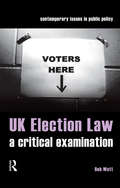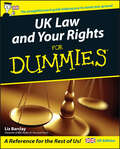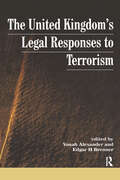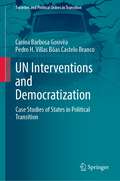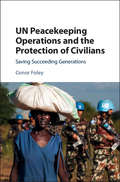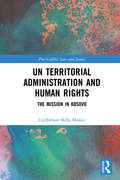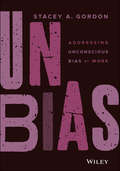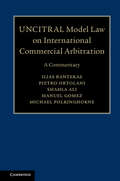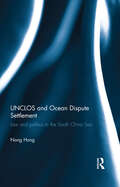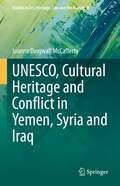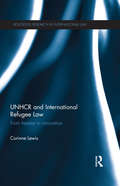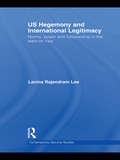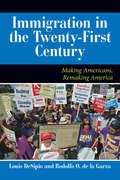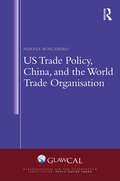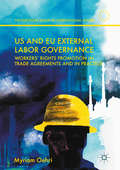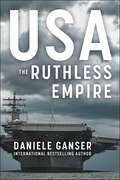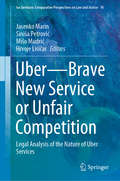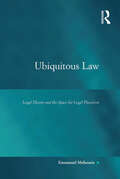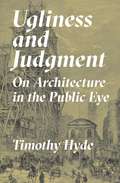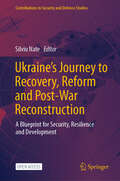- Table View
- List View
UK Election Law: A Critical Examination (Contemporary Issues In Public Policy Ser.)
by Bob WattThis book contains a critical analysis of the law and politics governing the conduct of statutory elections in the United Kingdom. The author argues that elections have now become a marketplace for 'buying' the most seemingly attractive political party on offer into power, rather than an expression of democratic self-government. Thematically arranged, he considers a number of issues dating from before the Civil War through nineteenth century reforms to the foundation of the Electoral Commission and up to their paper 'Securing the Vote' published in 2005. The book Framing the debate for the Electoral Administration Bill 2005, it contains, amongst other legal analysis, analyses leading cases, including:Sanders v ChichesterR v JonesR v Whicher; ex parte MainwaringIn re Fermanagh and South Tyrone. The author presents an argument for a radical reappraisal of election law which involves, rather than excludes the self-governing citizenry, suggesting that election law, perhaps above all other kinds of law, should be the subject of vigorous and open public debate.
UK Law and Your Rights For Dummies
by Liz BarclayDo you know your legal rights and responsibilities if you're buying or selling a home, moving in with your partner, returning goods, getting your personal finances in order or dealing with a problematic neighbour? There are a multitude of legal rights to protect individuals, and most of us don't consider them until faced with an immediate legal problem. Boost your legal know-how with this simple guide that does away with the jargon and complication of the law, and helps you get a handle on a wide range of everyday legal issues. UK Law and Your Rights For Dummies shows you how to cut through the reams of red tape, avoid legal pitfalls and prepare yourself to deal with any situation.
UK's Legal Responses to Terrorism
by Yonah Alexander Edgar H BrennerFirst published in 2003. Routledge is an imprint of Taylor & Francis, an informa company.
UK, EU and Global Administrative Law
by Paul CraigPaul Craig's analysis of UK, EU and global administrative law examines the challenges facing each system and reveals the commonalities in and differences between their foundational assumptions. The challenges which they face may be particular to that legal order, endemic to any legal system of administrative law or the result of interaction between the three systems. The inter-relationship between the three levels is important. The legal and practical reality is that developments at one level can have an impact on the other two. Legal doctrine fashioned at the national level may therefore inform developments in EU and global administrative law. The doctrine thus created may then function symbiotically, shaping developments within a domestic legal order. The inter-relationship is equally marked from the regulatory perspective, since many such provisions originate at the global or EU level.
UN Interventions and Democratization: Case Studies of States in Political Transition (Societies and Political Orders in Transition)
by Carina Barbosa Gouvêa Pedro H. Castelo BrancoThis book analyzes United Nations (UN) interventions in the process of constitution making in states undergoing political change. It combines theoretical considerations of democracy and constitutionalism with empirical experiences and takes a critical perspective on the interventions developed by the United Nations in the processes of re-democratization. Presenting new empirical evidence on the substantive and procedural way in which the UN undertakes constitution building in Cambodia, Bosnia and Herzegovina, Afghanistan, and East Timor, the book illustrates difficulties of these practices such as the promotion of popular participation, as well as an increasing Westernization, and to meet local needs. In consequence, the authors call for reforms of the actions and structural methods the UN to better align a legitimate constitutional order with the rule of law and democratic values. This book is aimed at scholars and students of politics and law who are interested in the prerequisites and conditions for further democratization in states undergoing political transformation.
UN Peacekeeping Operations and the Protection of Civilians: Saving Succeeding Generations
by Conor FoleyOver 100,000 United Nations uniformed peacekeeping personnel are deployed on missions with authority from the Security Council to protect civilians in conflict zones. Chapter VII of the UN Charter allows for the use of force on UN missions, but does not list the rules governing the use; they are found in either the jus in bello provisions of international humanitarian law (IHL) or the regulations on the use of force in international human rights law. The UN Charter specifies that its provisions take precedence over all other international treaties. While the UN acknowledges the relevance of IHL to its missions, this book argues that the regulations of international human rights law usually provide more appropriate guidance. UN missions mandated to protect civilians have repeatedly failed to do so, and mechanisms need to be created to improve their accountability to those that they are responsible for protecting.
UN Territorial Administration and Human Rights: The Mission in Kosovo (Post-Conflict Law and Justice)
by Gjylbehare Bella MuratiThis book offers an original and insightful analysis of the human rights inadequacies that arise in the practice of UN territorial administration by analysing and assessing the practice of UNMIK. It provides arguments based on law and principles to support the thesis that a comprehensive legal framework governing the activities of the UN mission is a crucial prerequisite for its proper functioning. This is complemented by a discussion of several emerging issues surrounding the UN activity on the ground, namely, its legislative, judicial, and executive power. The author offers an extensive and well-documented analysis of the UN’s capacity as a surrogate state administration to respond to the needs of the governed population and, above all, protect its fundamental rights. Based on her findings, Murati concludes that only a comprehensive mandate can serve the long term interests of the international community’s objective to efficiently promote, protect, and fulfil human rights in a war-torn society. UN Territorial Administration and Human Rights provides a detailed critical legal analysis of one of the major UN administrations of territory after the Cold War, namely, the UN administration of Kosovo from 1999 to 2008. The analysis in this book will be beneficial to international law and international relations scholars and students, as well as policymakers and persons working for international organisations. The analysis and the lessons learned through this study shed light on the challenges entailed in governing territories and rebuilding state institutions while upholding the rule of law and ensuring respect for human rights.
UNBIAS: Addressing Unconscious Bias at Work
by Stacey A. GordonLet the CEO of Rework Work help you understand diversity, equity, and inclusion concepts to actively remove bias from the workplace Dismantling unhealthy workplaces involves much more than talking about it, and more than charts, graphs, and statistics—it requires action. Although it’s increasingly common for businesses of all shapes and sizes to appreciate the importance of diversity and inclusion in the workplace, many are often unaware of bias in the cultures they’ve created. Others might know there’s a problem, but don’t know how to properly address it. UNBIAS: Addressing Unconscious Bias At Work helps you understand concepts of workplace diversity, equity, and inclusion, shows you how to identify bias, and provides you with the tools for actively removing barriers and ensuring equity throughout your organization. Written by Stacey Gordon—CEO of Rework Work, a company on a mission to reduce bias in global talent acquisition and management—this real-world handbook offers step-by-step guidance on creating workplace cultures where employees feel they belong. UNBIAS teaches you to: Identify and address bias in the workplace Understand what you can do to be more inclusive Handle potentially uncomfortable conversations Discuss race in an authentic and meaningful way Use workplace-proven tools that make concepts of diversity and equity actionable Help your employee resource groups without giving them extra work Place accountability on organizational policies that allow biased behavior UNBIAS is a must-have resource for all employers, managers, and HR professionals seeking to create and sustain healthy, inclusive, and equitable workplace environments.
UNCITRAL Model Law on International Commercial Arbitration: A Commentary
by Ilias Bantekas Pietro Ortolani Shahla Ali Manuel A. Gomez Michael PolkinghorneThis book provides a comprehensive commentary on the UNCITRAL Model Law on International Arbitration. Combining both theory and practice, it is written by leading academics and practitioners from Europe, Asia and the Americas to ensure the book has a balanced international coverage. The book not only provides an article-by-article critical analysis, but also incorporates information on the reality of legal practice in UNCITRAL jurisdictions, ensuring it is more than a recitation of case law and variations in legal text. This is not a handbook for practitioners needing a supportive citation, but rather a guide for practitioners, legislators and academics to the reasons the Model Law was structured as it was, and the reasons variations have been adopted.
UNCLOS and Ocean Dispute Settlement: Law and Politics in the South China Sea
by Nong HongThe United Nations Convention on the Law of the Sea (UNCLOS) offers a legal framework for the sustainable development of the oceans and their natural resources. However, recently there have been calls to amend the Convention due to some ambiguous provisions which are unable to address a variety of contemporary maritime issues. This book evaluates the applicability and effectiveness of UNCLOS as a settlement mechanism for addressing ocean disputes. The book’s central focus is on the South China Sea (SCS) dispute, one of the most complex and challenging ocean-related conflicts in the world. The book examines the ways in which an emphasis on sovereignty, threats to maritime security and overlapping maritime claims caused by the newly established maritime regimes authorized by UNCLOS are all contributing factors to the SCS dispute. The book considers the internal coherence of the Law of the Sea Convention regime and its dispute settlement procedures. It looks at participation in the UNCLOS negotiations, maritime legislation, and the dispute settlement practice of relevant States party to the SCS dispute. The author goes on to explore the relationship between UNCLOS and the regimes and institutions in the SCS, particularly in regard to issues of maritime security, marine environment protection, joint development of oil and gas and general political interaction. The author proposes practical mechanisms to resolve the dispute whilst also offering a final judgement on the effectiveness of UNCLOS for settling disputes. UNCLOS and Ocean Dispute Settlement will be of particular interest to academics, students and policy makers of international, shipping and maritime law as well as being of interest to academics and students in the field of international relations.
UNESCO, Cultural Heritage and Conflict in Yemen, Syria and Iraq (Studies in Art, Heritage, Law and the Market #8)
by Joanne Dingwall McCaffertyThis book aims to determine UNESCO's capability to facilitate heritage protection measures pre-conflict, emergency response measures during conflict and reconstruction efforts post-conflict. The book employs document analysis to ascertain UNESCO's legal obligations when it comes to facilitating cultural heritage protection in its Member States' territories in the condition of armed conflict, while drawing comparisons with the reality of the organisation's presence and involvement in Yemen, Syria and Iraq. This study maps shifts in UNESCO's level of communication with each country's respective government and civil authorities; allocation of financial, human and material resources; and implementation of heritage safeguarding and reconstruction initiatives. Both quantitative and qualitative data shows UNESCO to exhibit great inequity in engagement, at times, closing communications entirely with Syria, due to the political standpoints of other UNESCO Member States. This political gridlock is often shown to result in the organisation overstating its ability to safeguard or restore heritage, with promises not being followed up with action. Since 2015, UNESCO has expressed a stronger intent to be a key player in heritage protection during armed conflict, however as long as cultural heritage protection is not considered a humanitarian concern, UNESCO will not be able to circumvent much of the political and bureaucratic barriers facing intergovernmental organisations during conflict, which prevent emergency action from being implemented. In order to ensure heritage safeguarding is permitted during periods of significant unrest, regardless of political discord, it is crucial that UNESCO promote a people-centred approach to its cultural heritage protection initiatives. This book evidences that focusing on livelihoods and meaningful and practical connections between populations and their local heritage to be UNESCO's optimal methodological approach for justifying cultural heritage protection as a humanitarian necessity. The book's readership includes academics, researchers, and practitioners in the fields of political science, law and heritage studies.
UNHCR and International Refugee Law: From Treaties to Innovation (Routledge Research in International Law)
by Corinne LewisThis book considers the United Nations High Commissioner for Refugees’ contribution to international refugee law since the establishment of UNHCR by the United Nations General Assembly in 1951. The book explores the historical and statutory foundations that create an indelible link between UNHCR and international refugee law. This book charts the significant evolution that has occurred in the organisation’s role throughout the last sixty years, looking at both the formal means by which UNHCR’s mandate may be modified, and the techniques UNHCR has used to facilitate the changes in its role, thereby revealing a significant evolution in the organisation’s role since the onset of the crisis in refugee protection in the 1980’s. UNHCR, itself, has demonstrated its organizational autonomy as the primary agent for the adaptation of its responsibilities and work related to international refugee law. The author does suggest however that UNHCR needs to continue to extend and strengthen its role related to international refugee law if UNHCR is to ensure a stronger legal framework for the protection of refugees as well as a fuller respect for refugees’ rights in practice. UNHCR and International Refugee Law should be of particular interest to refugee lawyers as well as academics and students of refugee law and international law, and anyone concerned with the important role that UNHCR plays in the protection of refugees today.
US Hegemony and International Legitimacy: Norms, Power and Followership in the Wars on Iraq (Contemporary Security Studies)
by Lavina Rajendram LeeThis book examines US hegemony and international legitimacy in the post-Cold War era, focusing on its leadership in the two wars on Iraq. The preference for unilateral action in foreign policy under the Bush Administration, culminating in the use of force against Iraq in 2003, has unquestionably created a crisis in the legitimacy of US global leadership. Of central concern is the ability of the United States to act without regard for the values and interests of its allies or for international law on the use of force, raising the question: does international legitimacy truly matter in an international system dominated by a lone superpower? US Hegemony and International Legitimacy explores the relationship between international legitimacy and hegemonic power through an in depth examination of two case studies – the Gulf Crisis of 1990-91 and the Iraq Crisis of 2002-03 – and examines the extent to which normative beliefs about legitimate behaviour influenced the decisions of states to follow or reject US leadership. The findings of the book demonstrate that subordinate states play a crucial role in consenting to US leadership and endorsing it as legitimate and have a significant impact on the ability of a hegemonic state to maintain order with least cost. Understanding of the importance of legitimacy will be vital to any attempt to rehabilitate the global leadership credentials of the United States under the Obama Administration. This book will be of much interest to students of US foreign policy, IR theory and security studies. Lavina Rajendram Lee is a lecturer in the Department of Modern History, Politics and International Relations at Macquarie University, Australia, and has a PhD in International Relations from the University of Sydney.
US Immigration in the Twenty-First Century
by Louis Desipio Rodolfo O. de la GarzaImmigration in the Twenty-First Century is a comprehensive examination of the enduring issues surrounding immigration and immigrants in the United States, beginning with a look at the history of immigration policy, followed by an examination of the legislative and legal debates waged over immigration and settlement policies today and concluding with a consideration of the continuing challenges of achieving immigration reform in the United States. The authors also discuss the issues facing immigrants in the United States, from the reception of immigrants within the native population to the relationship between minorities and immigrants. Immigration and immigration policy continues to be a hot topic on the campaign trail, and in all branches of federal and state government. U. S. Immigrants and Immigration Policies in the Twenty-First Century provides students with the tools and context they need to understand these complex issues.
US Supreme Court Doctrine in the State High Courts
by Michael P. Fix Benjamin J. KassowUS Supreme Court Doctrine in the State High Courts challenges theoretical and empirical accounts about how state high courts use US Supreme Court doctrine and precedent. Michael Fix and Benjamin Kassow argue that theories that do not account for the full range of ways in which state high courts can act are, by definition, incomplete. Examining three important precedents – Atkins v. Virginia, Lemon v. Kurtzman, and DC v. Heller/McDonald v. Chicago – Fix and Kassow find that state high courts commonly ignore Supreme Court precedent for reasons of political ideology, path dependence, and fact patterns in cases that may be of varying similarity to those found in relevant US Supreme Court doctrine. This work, which provides an important addition to the scholarly literature on the impact of Supreme Court decisions, should be read by anyone interested in law and politics or traditional approaches to the study of legal decision-making.
US Trade Policy, China and the World Trade Organisation (Transnational Law and Governance)
by Nerina BoschieroThe last few years have been "anni horribiles" for in International Economic Law in general and in particular for the World Trade Organization, since its inception in 1995 the guarantor of the world multilateral trade system. The increasing trade tensions, a high level of US security tariffs on steel and aluminium, the US boycott of the WTO Appellate Body, the US-China "trade war" and the reasons underlining it, only aggravated a disastrous world-wide economic situation at a time of tremendous global health and societal emergency, due to the persistent devastating spread of the COVID-19 pandemic. The book critically discusses the most salient past US administration’s unilateralist and protectionist practices. At the same time investigating the new Biden Administration’s trade approaches in order to assess whether the precedent trade trajectory is likely to continue, or there is hope of reviving the US commitment to the rule-based multilateral trading system. The book’s goal consists in distilling from current legal events the reasoning that might help the next generations in obtaining what the world needs most. These are a conscious and voluntary return to multilateralism, the search of new forms of effective global cooperation, better trade policies, a more equitable globalization, sound legal arguments, and solid economic reasons to combat rising nationalisms. If enacted, these elements hopefully would contribute to defeat new risks of political conflicts and long-lasting "trade wars". The book will be helpful to students and scholars in international and trade law, political science, and also professionals working in international and EU institutions.
US and EU External Labor Governance
by Myriam OehriThis book provides a timely and in-depth analysis of how two major trade powers, the United States of America (US) and the European Union (EU), contribute to a socio-political dimension of globalization. Myriam Oehri documents US and EU labor standards promotion in Mexico, Morocco, and the Dominican Republic, drawing on an analysis of bilateral and regional trade agreements (NAALC, US-Morocco FTA, CAFTA-DR, EU-Mexico GA, EU-Morocco AA, and EU-CARIFORUM EPA) as well as extensive field work. The case studies reveal that for the advancement of labor norms, both punitive enforcement and cooperative engagement mechanisms are established in relevant agreements. In practice, the latter are more comprehensively used than the former, irrespective of diverse power relations between the US and the EU on the one hand and the three partner states on the other. The book will be of interest to advanced students and scholars in the fields of EU and US studies, foreign, trade, and social policy, regional integration, and international labor studies. It will also be of relevance to practitioners active in the international promotion of labor standards.
US-China Global Maritime Relations (Politics in Asia)
by Nong HongThis book explores the U.S.-China maritime relationship, examining the development and implementation of the maritime strategies of both the United States and China. Delving into the U.S.-China maritime relationship within the global context, the book investigates six key maritime regions: the South China Sea, the Northeast Asia waters (the East China Sea, the Yellow Sea), the Indian Ocean, the South Pacific Ocean, as well as the Arctic and Antarctic regions. Its observations form a comprehensive exploration of these regions and their significance in shaping the dynamics between the two nations, and this analysis reveals that an expanded view is necessary to discover and clearly display the role that these maritime regions currently—and could potentially—play in overarching U.S.-China relations. Examining both the ongoing conflicts and opportunities for cooperation in the global maritime domain between the United States and China, this book will be a valuable resource to students and scholars of international relations, Chinese and U.S. politics, strategic studies, and maritime studies.
USA: The Ruthless Empire
by Daniele GanserEmpires rise and fall; they do not last. In the eyes of many, the US exerts the strongest destabilizing influence on world events, and thus presents the greatest threat to world peace. World power #1 hasn&’t acquired this top position by chance. Since 1945, no other nation has bombed as many other countries or toppled as many governments as the US. It maintains the most military bases, exports the most weapons, and has the highest defense budget in the world. USA: The Ruthless Empire explains the background factors, motives, and resources of this world power.
Uber—Brave New Service or Unfair Competition: Legal Analysis of the Nature of Uber Services (Ius Gentium: Comparative Perspectives on Law and Justice #76)
by Jasenko Marin Siniša Petrović Mišo Mudrić Hrvoje LisičarThis book analyzes the legal issues connected with the provision of Uber-related services. It primarily focuses on the various contractual and non-contractual relationships that occur during the use of Uber applications, especially with reference to Uber headquarters (Uber App), Uber branch offices (advertisements), Uber partner drivers (employees or self-employed), Uber application registered users, Uber transportation service users (contracting passenger) and third-party Uber transportation service users (additional passenger). It also provides a comparison of standard transportation services and contracts of carriage, irrespective of whether the carrier in question is a common carrier, contractual carrier, actual carrier or an intermediary service provider. Furthermore, the book presents the relevant case law, especially with regard to Uber as a taxi service, Uber as a share-riding service, Uber as a rent-a-car with driver service, Uber as an employer and Uber as a key organizer of transportation service, in Croatia, Belgium, Germany, Italy, the Netherlands, United Kingdom, United States, Hungary, Argentina, and France. Lastly, it explores the different legislative approaches to resolving various issues related to the appearance of Uber and similar companies – the Laissez-faire model, Status Quo model, Legal Adjustment model, and the New Legislative Paradigm model.
Ubiquitous Law: Legal Theory and the Space for Legal Pluralism (Law, Justice And Power Ser.)
by Emmanuel MelissarisUbiquitous Law explores the possibility of understanding the law in dissociation from the State while, at the same time, establishing the conditions of meaningful communication between various legalities. This book argues that the enquiry into the legal has been biased by the implicit or explicit presupposition of the State's exclusivity to a claim to legality as well as the tendency to make the enquiry into the law the task of experts, who purport to be able to represent the legal community's commitments in an authoritative manner. Very worryingly, the experts' point of view then becomes constitutive of the law and parasitic to and distortive of people's commitments. Ubiquitous Law counter-suggests a new methodology for legal theory, which will not be based on rigid epistemological and normative assumptions but rather on self-reflection and mutual understanding and critique, so as to establish acceptable differences on the basis of a commonality.
Ubuntu Ethics: Human Dignity, Moral Perfectionism, and Needs (Routledge Studies in African Philosophy)
by Motsamai MolefeThis book provides a philosophical exposition of Ubuntu ethics, which it does by explaining the saying ‘a person is a person through other persons’. Written by one of the world’s leading scholars of African philosophy, the book first argues that the focus on umuntu (or, a person) in Ubuntu ethics as intrinsically valuable makes ethical humanism and human dignity vitally important. The book then goes on to consider the role of virtue ethics in driving an ideal of moral perfectionism. This, in turn, provides the basis for what a good society should be: a needs-based political theory. Providing an important guide through Ubuntu ethics as a moral system constructed in terms of moral perfectionism, it will be an important read for researchers of African philosophy, and of the philosophy of virtue ethics and moral perfectionism more generally.
Ugliness and Judgment: On Architecture in the Public Eye
by Timothy HydeA novel interpretation of architecture, ugliness, and the social consequences of aesthetic judgmentWhen buildings are deemed ugly, what are the consequences? In Ugliness and Judgment, Timothy Hyde considers the role of aesthetic judgment—and its concern for ugliness—in architectural debates and their resulting social effects across three centuries of British architectural history. From eighteenth-century ideas about Stonehenge to Prince Charles’s opinions about the National Gallery, Hyde uncovers a new story of aesthetic judgment, where arguments about architectural ugliness do not pertain solely to buildings or assessments of style, but intrude into other spheres of civil society.Hyde explores how accidental and willful conditions of ugliness—including the gothic revival Houses of Parliament, the brutalist concrete of the South Bank, and the historicist novelty of Number One Poultry—have been debated in parliamentary committees, courtrooms, and public inquiries. He recounts how architects such as Christopher Wren, John Soane, James Stirling, and Ludwig Mies van der Rohe have been summoned by tribunals of aesthetic judgment. With his novel scrutiny of lawsuits for libel, changing paradigms of nuisance law, and conventions of monarchical privilege, he shows how aesthetic judgments have become entangled in wider assessments of art, science, religion, political economy, and the state.Moving beyond superficialities of taste in order to see how architectural improprieties enable architecture to participate in social transformations, Ugliness and Judgment sheds new light on the role of aesthetic measurement in our world.
Ukraine's Journey to Recovery, Reform and Post-War Reconstruction: A Blueprint for Security, Resilience and Development (Contributions to Security and Defence Studies)
by Silviu NateThis open access volume explores Ukraine's challenges post-war, focusing on economic revival and sustainable development. Addressing scholars, policymakers, and practitioners the book discusses pivotal issues for the rebuilding of Ukraine, such as institutional changes, economic hurdles, social stability, and environmental rejuvenation. The book highlights the inevitable need for Ukraine's institutional transformation, essential for EU and NATO integration. It goes on to examine the global geopolitical and economic repercussions and emphasizes the pivotal role of energy independence in the European landscape. Through a multi-disciplinary lens encompassing political science, economics, and law, this book provides evidence-based insights and policy recommendations. Offering a comprehensive presentation of post-war challenges, it offers an invaluable guide for policymakers and practitioners interested in the complexities of Ukraine's reconstruction. This is an open access book.
Ukrainian Healthcare Law in the Context of European and International Law (European Union and its Neighbours in a Globalized World #7)
by Roman Maydanyk André Den Exter Iryna IzarovaThis is an increasingly timely book, focusing on issues arising from the impact of COVID-19 on the health care law of the Central and East European countries. It deals with dualism and system of health care law, depicts legal personality in the field of health care, examines property rights and turnover of human tissues, considers moral rights in this field, intellectual ownership in the field of medicine and pharmacy, contracts on health care and contracts on rendering medical services, the legal relationships of transplantology, post-mortem reproduction and donorship, features of family personal property rights in the field of health care, problems of legal regulation of medical workers labour, investigates private legal relationships of surrogate motherhood with foreign element. Special attention is given to the alternative resolution of health care disputes and impact of pandemic on the effective health rights protection. The book is intended for wide auditoria of scholars and practitioners, who engaged in health care rights protection, as well as judges and practicing lawyers, graduate and undergraduate students.
